BY SHEERLY AVNI
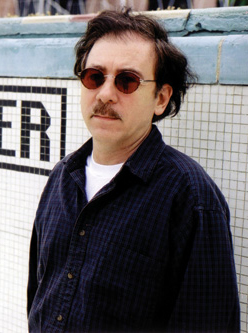 LAUGHING MATTER: Director Terry Zwigoff
LAUGHING MATTER: Director Terry Zwigoff
loves Fritz Lang's Scarlett Street.
(Credit: Suzanne Hanover)
"If I start paying attention to the mechanics of a film while watching it," says Terry Zwigoff, as a painting of a street lamp announces the opening credits of Fritz Lang's 1945
Scarlet Street, "then it's generally a bad film. I always get caught up in the story. I'd never watch a film like this for technique."
This is the first time Zwigoff has seen the newly restored print of the movie, and also the first time he's screened it on anything but a blurry VHS copy or the dimly remembered TV screens of his childhood. Along with The Blue Angel and W.C. Fields movies, Zwigoff remembers it as one of his Saturday afternoon entertainments, one he happily recalls as "pure black comedy."
It takes a certain sensibility to see this noirish fable of a would-be artist and all-around schlub who gets conned by a prostitute and her pimp, as comedy–black, gray or otherwise. To be more specific, it takes Zwigoff's sensibility, one which has always been, if not quite dark, at least disgruntled. From his unsparing documentary portraits of great artists Louie Bluie and Crumb, to his feature films like Bad Santa, the Bay Area director has focused on lonely characters at odds with both American culture and their own lesser instincts. His two collaborations with graphic novelist Daniel Clowes–Ghost World and Art School Confidential–have echoed specific themes in Scarlet Street: identity theft, grift, men who confuse muses with love objects, and the dubiously redemptive quality of the artistic impulse. Whether they are conscious or unconscious reflections of Lang's themes is something even Zwigoff himself is unsure of. "I don't know if this molded my worldview or if my worldview was already moving in this direction–it's hard to say. I think it may have just seeped into me."
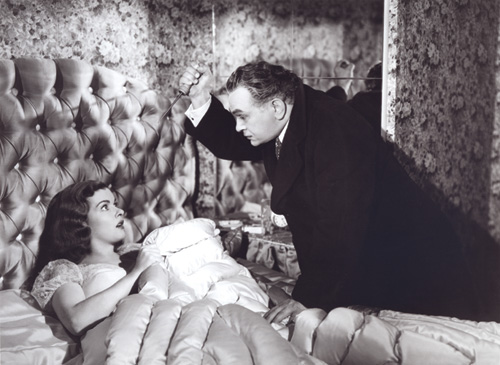 KILLER'S KISS: Edward G. Robinson gets his revenge on Joan
KILLER'S KISS: Edward G. Robinson gets his revenge on Joan
Bennett in Fritz Lang's Scarlett Street, a film that has delighted
Terry Zwigoff since he was a child. (Credit: AMPAS)
Scarlet Street is Lang's remake of the 1931 Renoir movie La Chienne (literally "The Bitch"). But while the first was lighthearted satirical fare, Scarlet Street is much bleaker, both in its tone and its pessimistic take on its three protagonists. "Darker, more downbeat, just the way I like it," chuckles Zwigoff.
Kitty March and her ne'er-do-well boyfriend Johnny Prince (Joan Bennett and Dan Duryea, in peak form) plot to take a wealthy painter for all he's worth. The only hitch is that the painter, Chris Cross (Edward G. Robinson), is running a scam of his own. He is neither wealthy nor famous–in reality he's an unhappily married cashier who desperately wants to be loved by a beautiful young girl. The one bright spot in his life is painting, which was once a professional aspiration and is now just a furtively pursued hobby.
"He's so pathetic!" says Zwigoff, in the film's first scene, as Chris (a subdued and uncharacteristically mousy Robinson) accepts a watch in reward for years of faithful service as a lowly cashier. A moment later, when Chris first meets his femme fatale in the rain, on a Hollywood sound stage meant to evoke Greenwich Village, Zwigoff points to Bennett's see-through raincoat–"decked out like a bon-bon!"
Again, Zwigoff takes note less of the camera work, the lighting, or even the sets than of the actors' choices, and the screenplay, zeroing in on the gestures that define personalities: Kitty flipping her cigarette into a sinkful of dirty dishes, spitting a seed out on the floor of her ratty apartment; Johnny Prince's perpetual sneer; and the fine points of Robinson's remarkable performance as the timid anti-hero.
"Look," says Zwigoff, delighted by a detail as Kitty and the infantilized Chris share a drink in a basement bar near her apartment. "He reaches for that straw every time he takes a sip of his drink–he can't even put his mouth to a glass on his own!"
Zwigoff's screening of the restored print has turned out to be less of an exercise in analysis than in rueful self-recognition, particularly as he watches Chris, contentedly painting away in the bathroom. His own film career was launched almost inadvertently as an extension of his own hobbies–an obsession with old-time music and collecting 78 rpm records. Even as a happily married success, Zwigoff still identifies wholly with Chris, the hen-pecked husband and would-be Cézanne, forced to pursue his life's passion in the bathroom of a two-room flat. "That's typical of a lot of 78 collectors I know," he says. "They're often forced to pursue their hobbies in the basement or up in the attic–not quite the bathroom, but that's a nice touch."
As he watches Chris' wife Adele, a harpy in a high-waisted skirt, follow her husband around the apartment, Zwigoff returns to his argument for reading the film as black comedy. "She's like Kathleen Howard [the despised wife] in a W.C. Fields movie. And her screeching is just nearly operatic like Kathleen Howard."
Now we are back in Johnny Prince's sleazy world, listening to his own ambitious plans for using Kitty to bleed her paramour dry. "The problem with you," announces Prince, hurling abuse at the besotted Kitty, whom he calls Lazylegs, for reasons that would have escaped an 8-year-old, "is that you have no imagination!"
"'No imagination!' That's great!," chortles Zwigoff. "This movie really is perfectly cast, and it's a great screenplay too [by legendary screenwriter Dudley Nichols] especially when you consider that Lang started out as a director of silents–in another country and another language. A good script and perfect casting, that's 90 percent of the work."
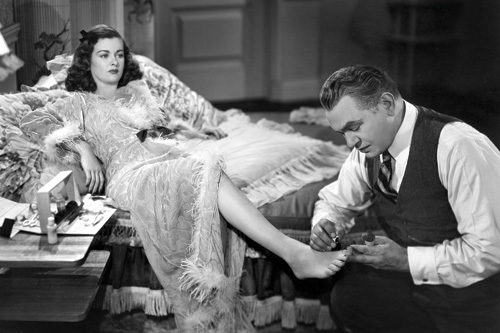
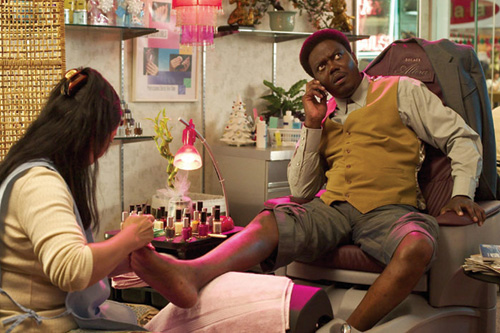 NAILED DOWN: Robinson painting Bennett's nails in Scarlett Street (top)
NAILED DOWN: Robinson painting Bennett's nails in Scarlett Street (top)
was Zwigoff's pedicure in Bad Santa (bottom). (Credits: Photofest; Miramax)
Zwigoff's admiration for the actors translates into appropriate contempt for their characters. Prince's own imagination extends only so far as to see the art's potential to bring in money. And Kitty gets no sympathy either. "She likes the rough stuff–it just confirms my worst fears about women and human nature," says Zwigoff.
When Duryea stomps off screen after administering another slap to Kitty's cheek, Zwigoff pauses to reflect on Lang's artistry. "There's nothing fancy in terms of camera work so far. It's very tasteful and efficient."
Having made his pronouncement about the craft, Zwigoff lights a cigarette and goes back to enjoying the story, chuckling every few minutes at Chris' expense. When Kitty suggests that Chris seems a bit buttoned down, Zwigoff shakes his head: "buttoned-down? How about, 'coiled like a snake, ready to spring'?"
And then, a few minutes later, the screen bears out the comparison. Kitty has convinced Chris to embezzle money and rent a love nest, where she can live and he can paint. Now the chuckles give way to a guffaw, as Chris, love-struck and still clueless, tries a seducer's move: "Would you like to see my paintings?"
Zwigoff claps his hands together, his gray-green eyes lighting up. "That's exactly the line that Jim Broadbent uses in Art School Confidential: 'Would you like to see my paintings?' How pathetic."
The most intricately staged scenes in the movie take place in the new apartment, three rooms separated by glass walls. It's there that top New York critics visit Kitty and Prince, looking for the painter of the work Prince has been trying to sell around town. The shady couple seizes the moment and claims Kitty is the artist. She has moved from stealing Chris' paintings to stealing his very identity. The elegant apartment serves as a minimalist backdrop for the characters' sleazy con and Chris' final murderous frenzy.
"These scenes are so well-staged and blocked," says Zwigoff, "but nothing ever seems static. People always have something to do on screen, but the key is that Lang never lets that get in the way of characterizations; it all seems to come very organically out of these characters and their squalid dilemmas."
In a Hollywood ruled by the Hayes Code, where the economics of sexual exchange could only be suggested, that squalor reveals itself mercilessly in a scene where Kitty, scornful and seductive in her negligee, finally permits Chris to paint her–not her likeness, her toenails. "I'm sure they'll be a masterpiece," she sneers, as Chris sets to work.
"On a conscious level," says Zwigoff, "I'm pretty sure this is the only scene I consciously stole or paid homage to, for the toenail painting scene in Bad Santa–which I also stole from Kubrick's Lolita." In fact, Zwigoff owns a still of the scene, which he bought at a flea market when he was a child. But what he really wants are the paintings Lang used in the film, which were actually the work of respected California painter John Decker. "They are strong–they captured the truth of what a guy would paint like, very primitive but with certain strength to them, it's very hard to do. Most films don't get it right at all, you don't feel like the art work was actually created by the character in the film."
It's a challenge Zwigoff has faced and conquered several times himself. Robert Crumb's daughter Sophie supplied the drawings for Enid's notebook in Ghost World. For Art School Confidential, the filmmakers spent months searching for paintings that could represent the talents of students. For one character, they finally gave up and Clowes did the paintings himself.
On screen, Chris is hard at work in the kitchen, chopping meat with a butcher's knife, thoroughly emasculated in his flowered apron. Adele is taking him to task, this time because she's seen his work in a gallery and believes he's been copying all this time from an artist named Kitty March.
Lang's camera zooms in on the knife, and Zwigoff leans forward. "Hey wait," he says. "Can we rewind this scene? The continuity wasn't quite right. He had the knife up like he was about to use it, but when you cut back it's not there... maybe it's intentional, maybe Lang was trying to show what was happening in Chris' impotent mind. That's pretty subtle if it is."
On second viewing, it turns out the scene is one continuous shot. Again the derisive laugh, this time directed at himself. "So much for my theory... it was totally unfounded. That's the danger of letting myself try to read into the movie, and see it like a critic. It's just what critics do with my work, reading in things that I never intended."
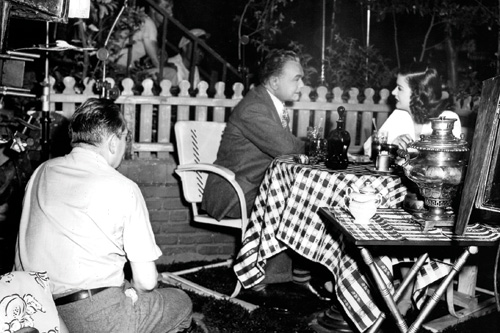 HOOKED: Director Fritz Lang stages a cozy dinner shot as Bennett
HOOKED: Director Fritz Lang stages a cozy dinner shot as Bennett
sets her trap for the unsuspecting Robinson. (Credit: AMPAS)
Chris discovers the full extent of his own cuckoldry–and finally confronts Kitty, resplendent in satin and scorn. "You're old and you're ugly and I'm sick of you!" she screams, and Chris responds appropriately, by picking up an ice pick. Again, it's a dark scene, but Zwigoff is laughing. "This totally plays like high farce!"
Then, as Chris goes on trial for killing Kitty, Zwigoff's cynicism gives way to appreciation. Character after character takes the stand in defense of Chris on starkly lit sets against a blank wall. "Oh wow, Lang's certainly saving production money on the court sequences." The witnesses damn him to innocence by insisting that there's no way he could have painted Kitty March's artwork, and therefore no way he'd have a motive to murder her.
"This part seems much darker than I remember," admits the director, "much more in noir territory, especially the more expressionistic scenes." Cleared by the law but still doomed, Chris wanders the streets, homeless, alone, unable to paint or even take his own life.
It's a somber ending, but Zwigoff is clearly delighted. "Honestly," he adds, reaching into his cigarette pack for an American Spirit, as "The End" flashes over the movie's bitter finale, "I never realized just how much my own films have had to do thematically with this one. Unconsciously, it must have made an even stronger impression than I thought. You know this movie is very similar to Woman in the Window, which Lang made right before it. Maybe that's just what directors do–you make the same movie over and over again, until you get it right."